April 4, 2020
GreenHomeNYC Forum on Sustainable Food Trends
By Pamela Berns
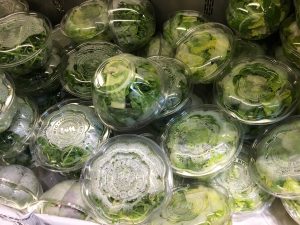
Photo by Pamela Berns
As the saying goes, we are what we eat. In addition to being the basis for our very survival, food is important to human beings on many levels, from psychological to cultural, from aesthetic to economic. Yet some of the stats on food’s relation to climate change can make getting your daily requirements look like a recipe for disaster. Food systems emit about a quarter of our greenhouse gas emissions, which includes gases produced by food waste—a third of all food produced globally is wasted. The US tops that at 40%. And that’s just the beginning of the story.
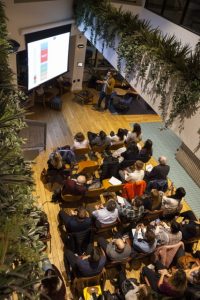
Photo by Alison Moon
The facts may feel overwhelming, but all this data can actually give us cause for optimism, as they illuminate opportunities to change the way we live and catalyze some pretty impressive action. The speakers at GreenHome NYC’s February 19 Forum on Sustainable Food Trends certainly demonstrated that through knowledge, innovation and the ingenuity of some really smart people, new and unexpected business models can emerge that actually align our individual health with the health of the planet.
AeroFarms literally flips farming on its side with the largest vertical farm of its kind in the world, producing sustainable greens under perfect growing conditions in a repurposed abandoned steel mill in industrial Newark. The
Food For All app is virtually eliminating restaurant food waste while democratizing access and creating a whole new customer base.
Loop has moved beyond recycling to a closed loop system designed to eliminate disposability from packaging altogether, while putting consumer preferences front and center.
Note: Click these links for COVID-19 initiatives from
AeroFarms,
Food For All and
Loop .

Original Photo by Alison Moon
NYU Assistant Professor
Matthew Hayek models the potential impact of large-scale dietary changes, comparing a shift in food consumption habits to cutting edge carbon mitigation strategies such as bio energy and carbon capture. He says that our biggest impact will come from “eliminating food waste and introducing and normalizing plant-based diets. These two solutions are interlinked.” That makes our speakers more than a random collection entrepreneurial kindred spirits—they are part of a critical system.
The United States of Meat
That’s the way Matthew described Americans’ farming practices. Contrary to what many of us think, Matthew told us, transporting food accounts for only 6% of food-related emissions. The rest is from from land use, crop production and livestock. Here’s some math that might make you think twice about putting meat on your menu:
95% of massive deforestation is from cattle ranching—“clearing and burning the rainforest to make way for cheap beef.”
44% of the world’s edible crops are fed to animals.
It takes 9 calories of grain to produce just 1 calorie of chicken.
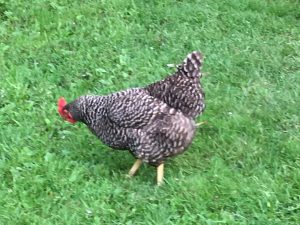
Photo by Pamela Berns
Also contrary to popular belief, free-range farming is not necessarily good for the planet. While free-range animals are raised more humanely and don’t rely on greenhouse gas-producing grain crops, they pick up a lot of the difference in land use, requiring 3 times the land of their grain-fed cousins. They also take longer to fatten up, so they roam longer, producing additional greenhouse gases, such as methane.
Changing our behavior one meal at a time will certainly help, but Matthew’s research findings point to even bigger solutions. “Institutional change, such as replacing the default at events and in cafeterias with plant-based main courses and desserts, could turn meat into a stranded asset.”
(Keep an eye out for Matthew’s upcoming GreenHomeNYC blogspot for more ways to reduce your Carbon “FoodPrint”)
AeroFarms: The Science of Sustainable Salad
As we move to more plant-based diets, leveraging new technology to grow the plants sustainably is key. Growing up rather than out enables AeroFarms to produce crops of greens on a fraction of the land and in much less time than it takes to grow them in the field, said Marketing and Communications Manager Emily Gee. To make that possible, AeroFarms’ award winning aeroponic technology provides the perfect conditions. The company employs a team of, engineers, foodies, plant scientists and other scientists who break down the sustainable growing process into almost infinitesimal detail.
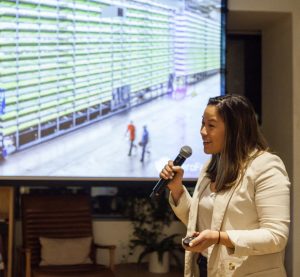
Photo by Alison Moon
To conserve water, a fine mist is calibrated to give each plant precisely the amount of water it needs. And because the plants are grown in a controlled indoor environment, pesticides are not used, and triple washing isn’t necessary: the greens are harvested, cooled and packaged, ready to eat straight out of the container. AeroFarms’ patented aeroponic growing method enables them to use 95% less water than field farming. It also eliminates food waste. All told, up to 75% of greens are lost in traditional farming and cleaning practices, when you consider what gets left behind in the field, in the washing process, and in transportation. To reduce energy consumption, AeroFarms’ scientists have identified the parts of the light spectrum required to grow each type of green, eliminating the need for across-the-board full spectrum lighting. To ensure that the greens are nutritious, each type of plant is fed its own customized nutrient recipe.
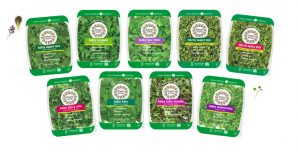
Packaging is designed to ensure that the greens, which are shipped only locally within 24 hours of harvesting, stay fresh as long as possible, while also using 40% less plastic than the usual clamshells. That means customers can buy fresh, delicious local greens all year round, rather than long-distance produce trucked all the way from the Salinas Valley in California.
Food for All: Waste Not Want Not
If the process at AeroFarms is as fine tuned as a Stradivarius violin, for restaurants, meeting customer expectations is more like improvisational Jazz. “It’s hard to predict how many people will turn up in any given day,” said Food For All Co-founder Sabine Valenga. So restaurants often overproduce, which reduces profits and increases waste to landfills.
Over 700,000 restaurants throw away more than 11M tons of food every year in the US, the equivalent of of 1.2 billion meals. “That’s not food waste. That’s wasted food,” said Sabine.
And we’re not just throwing away the item but also all the resources that are embedded in its production. Food waste consumes:
21% of fresh water
19% of fertilizers
18% of crop land
21% of land fill volume
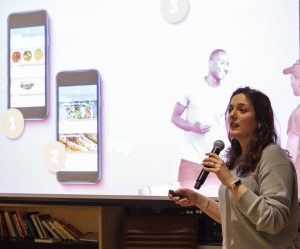
Photo by Alison Moon
All told, food waste adds up to 218 billion dollars in lost revenue in the US alone. If food waste was a country,” said Sabine, “it would be third in the list of emitters, after the US and China.”
Enter the Food for All app. Available on both IOS and Android platforms, it’s straightforward and easy to use. “Restaurants & cafes near you offer their surplus meals for at least 50% off. Reserve the meal and pay through the app. Go to the restaurant at the pickup time, show them your receipt and enjoy your meal as takeout,” explains the How It Works link in the app. You can search a restaurant by name or zip code. As of this writing, 216 restaurants in New York and Boston participate, and the numbers promise to grow.
Loop: From Disposable to Durable
Loop’s global platform “enables consumer product companies and retailers to shift from a disposable supply chain to a durable one.” With only 15% of plastics properly recycled in our current system, the environmental equation makes sense.
A future-forward company, Loop takes its inspiration from the past— the iconic milkman. Unlike the disposable packaging of today, which is considered a cost of goods sold for a business, durable, refillable bottles were an asset owned by the milkman. While it is more expensive to procure a durable container, when we look at the economics from a price per fill perspective, reusable packaging can reduce costs. Supply Chain Planner, Andy Rose, explained that “the more durable the package is the lower the cost per fill.”
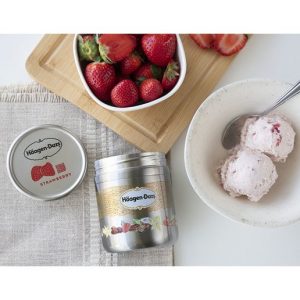
https://loopstore.com/
Loop’s closed loop approach doesn’t attempt to change the way people think, but rather “accept[s] the challenge of innovating and offering something new and better with people as they are,” said Andy. “Customer delight” drives the model, so the focus is on affordability and convenience. For Loop customers, the process is simple: The product is delivered in reusable, durable packaging. When you’re done with it, you simply place the package back into a Tote supplied by Loop, and schedule a free pick up from your home. No need to trash, recycle, or clean anything. Loop hygienically cleans and replenishes what you’ve returned.
From an aesthetic perspective, form definitely follows function. Durability enhances design possibilities and opens the door to new features. Consumers are “delighted” to display their Loop products on their counters and throughout their home. “You want to hold onto that shiny thing,” quipped Andy. But that rarely happens, as Loop’s refundable deposit fee is “a financial incentive for the consumer to return it.”
Moving Forward Takes a Movement
“Since the beginning we understood that…we would need much more than a smart and innovative solution; we would need a whole movement that supports our cause,” says the Food For All website. The speakers at this Forum are most definitely doing both.
Thanks to
WeWork for hosting our sold out crowd in your beautiful space. We look forward to partnering with you again soon, when we resume our live in-person events.
 Packaging is designed to ensure that the greens, which are shipped only locally within 24 hours of harvesting, stay fresh as long as possible, while also using 40% less plastic than the usual clamshells. That means customers can buy fresh, delicious local greens all year round, rather than long-distance produce trucked all the way from the Salinas Valley in California.
Food for All: Waste Not Want Not
If the process at AeroFarms is as fine tuned as a Stradivarius violin, for restaurants, meeting customer expectations is more like improvisational Jazz. “It’s hard to predict how many people will turn up in any given day,” said Food For All Co-founder Sabine Valenga. So restaurants often overproduce, which reduces profits and increases waste to landfills.
Over 700,000 restaurants throw away more than 11M tons of food every year in the US, the equivalent of of 1.2 billion meals. “That’s not food waste. That’s wasted food,” said Sabine.
And we’re not just throwing away the item but also all the resources that are embedded in its production. Food waste consumes:
21% of fresh water
19% of fertilizers
18% of crop land
21% of land fill volume
All told, food waste adds up to 218 billion dollars in lost revenue in the US alone. If food waste was a country,” said Sabine, “it would be third in the list of emitters, after the US and China.”
Enter the Food for All app. Available on both IOS and Android platforms, it’s straightforward and easy to use. “Restaurants & cafes near you offer their surplus meals for at least 50% off. Reserve the meal and pay through the app. Go to the restaurant at the pickup time, show them your receipt and enjoy your meal as takeout,” explains the How It Works link in the app. You can search a restaurant by name or zip code. As of this writing, 216 restaurants in New York and Boston participate, and the numbers promise to grow.
Loop: From Disposable to Durable
Loop’s global platform “enables consumer product companies and retailers to shift from a disposable supply chain to a durable one.” With only 15% of plastics properly recycled in our current system, the environmental equation makes sense.
A future-forward company, Loop takes its inspiration from the past— the iconic milkman. Unlike the disposable packaging of today, which is considered a cost of goods sold for a business, durable, refillable bottles were an asset owned by the milkman. While it is more expensive to procure a durable container, when we look at the economics from a price per fill perspective, reusable packaging can reduce costs. Supply Chain Planner, Andy Rose, explained that “the more durable the package is the lower the cost per fill.”
Loop’s closed loop approach doesn’t attempt to change the way people think, but rather “accept[s] the challenge of innovating and offering something new and better with people as they are,” said Andy. “Customer delight” drives the model, so the focus is on affordability and convenience. For Loop customers, the process is simple: The product is delivered in reusable, durable packaging. When you’re done with it, you simply place the package back into a Tote supplied by Loop, and schedule a free pick up from your home. No need to trash, recycle, or clean anything. Loop hygienically cleans and replenishes what you’ve returned.
From an aesthetic perspective, form definitely follows function. Durability enhances design possibilities and opens the door to new features. Consumers are “delighted” to display their Loop products on their counters and throughout their home. “You want to hold onto that shiny thing,” quipped Andy. But that rarely happens, as Loop’s refundable deposit fee is “a financial incentive for the consumer to return it.”
Moving Forward Takes a Movement
“Since the beginning we understood that…we would need much more than a smart and innovative solution; we would need a whole movement that supports our cause,” says the Food For All website. The speakers at this Forum are most definitely doing both.
Thanks to WeWork for hosting our sold out crowd in your beautiful space. We look forward to partnering with you again soon, when we resume our live in-person events.
Packaging is designed to ensure that the greens, which are shipped only locally within 24 hours of harvesting, stay fresh as long as possible, while also using 40% less plastic than the usual clamshells. That means customers can buy fresh, delicious local greens all year round, rather than long-distance produce trucked all the way from the Salinas Valley in California.
Food for All: Waste Not Want Not
If the process at AeroFarms is as fine tuned as a Stradivarius violin, for restaurants, meeting customer expectations is more like improvisational Jazz. “It’s hard to predict how many people will turn up in any given day,” said Food For All Co-founder Sabine Valenga. So restaurants often overproduce, which reduces profits and increases waste to landfills.
Over 700,000 restaurants throw away more than 11M tons of food every year in the US, the equivalent of of 1.2 billion meals. “That’s not food waste. That’s wasted food,” said Sabine.
And we’re not just throwing away the item but also all the resources that are embedded in its production. Food waste consumes:
21% of fresh water
19% of fertilizers
18% of crop land
21% of land fill volume
All told, food waste adds up to 218 billion dollars in lost revenue in the US alone. If food waste was a country,” said Sabine, “it would be third in the list of emitters, after the US and China.”
Enter the Food for All app. Available on both IOS and Android platforms, it’s straightforward and easy to use. “Restaurants & cafes near you offer their surplus meals for at least 50% off. Reserve the meal and pay through the app. Go to the restaurant at the pickup time, show them your receipt and enjoy your meal as takeout,” explains the How It Works link in the app. You can search a restaurant by name or zip code. As of this writing, 216 restaurants in New York and Boston participate, and the numbers promise to grow.
Loop: From Disposable to Durable
Loop’s global platform “enables consumer product companies and retailers to shift from a disposable supply chain to a durable one.” With only 15% of plastics properly recycled in our current system, the environmental equation makes sense.
A future-forward company, Loop takes its inspiration from the past— the iconic milkman. Unlike the disposable packaging of today, which is considered a cost of goods sold for a business, durable, refillable bottles were an asset owned by the milkman. While it is more expensive to procure a durable container, when we look at the economics from a price per fill perspective, reusable packaging can reduce costs. Supply Chain Planner, Andy Rose, explained that “the more durable the package is the lower the cost per fill.”
Loop’s closed loop approach doesn’t attempt to change the way people think, but rather “accept[s] the challenge of innovating and offering something new and better with people as they are,” said Andy. “Customer delight” drives the model, so the focus is on affordability and convenience. For Loop customers, the process is simple: The product is delivered in reusable, durable packaging. When you’re done with it, you simply place the package back into a Tote supplied by Loop, and schedule a free pick up from your home. No need to trash, recycle, or clean anything. Loop hygienically cleans and replenishes what you’ve returned.
From an aesthetic perspective, form definitely follows function. Durability enhances design possibilities and opens the door to new features. Consumers are “delighted” to display their Loop products on their counters and throughout their home. “You want to hold onto that shiny thing,” quipped Andy. But that rarely happens, as Loop’s refundable deposit fee is “a financial incentive for the consumer to return it.”
Moving Forward Takes a Movement
“Since the beginning we understood that…we would need much more than a smart and innovative solution; we would need a whole movement that supports our cause,” says the Food For All website. The speakers at this Forum are most definitely doing both.
Thanks to WeWork for hosting our sold out crowd in your beautiful space. We look forward to partnering with you again soon, when we resume our live in-person events.







